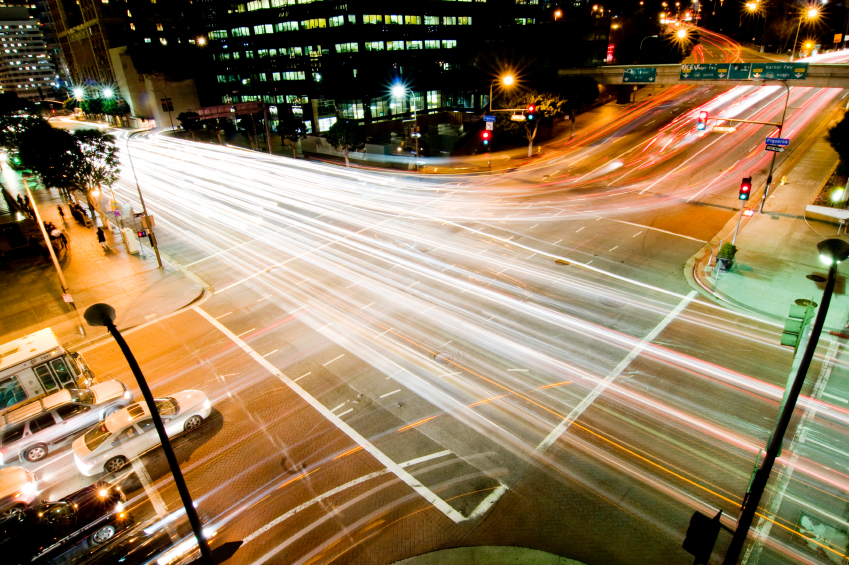The funding model of our roads and other transit infrastructure is broken — what happens now?
Background: An unexpected side effect of increased fuel efficiency and fewer miles driven in personal vehicles is that the government is collecting (much!) less fuel tax revenue — withering the coffers at state and federal levels. This means that our government is increasingly incapable of giving us the roads and transit we need.
I recently chaired a panel discussion at the Intelligent Transportation Society of America (ITSA), and myself, the three panel members, and 30 very active leaders from the transportation community had a lively discussion on this very topic. Here are some of the takeaways from our conversation.
New funding models, new opportunities
Funding models from one generation rarely repeat themselves the next. The model that funded railroads was useless when it came to building the interstate. The model that built the Internet is not the model that sustains it.
The disruption of traditional funding — a move to increased tolling, mileage-based fees and other revenue streams — is actually a potential boon to private sector providers, if you know where to look.
Business model thinking is already shifting in response to this funding pressure. Consumers still need roads, even if the government funding model that previously paid for them isn’t functional. And when there is an unmet need, there is an opportunity for private sector innovation and profit.
Three projects in particular caught my attention, each at the intersection of policy, technology and economic opportunities. Each of these requires public and private sector cooperation, and each could break open large scale revenue opportunity.
1. Trading Pavement for Data
Imagine the Internet in physical space, with packets of data becoming people moving through their daily routines. The profusion of location-enabled devices create enormous databases of information, a physical Internet, if you will. Imagine the potential of having real-time information about who passes your business everyday – perhaps sending a coupon for pizza to someone you know is rushing home to pick up the kids for a soccer match and won’t have time to cook dinner.
Since it wouldn’t be possible to collect most of this data without sensors and other assets created through public investment, the public sector has many of the chairs at this table. The private sector (think Big Data) brings the enormous capability to decode and provide business models for this information.
There are several possibilities for how this partnership could play out. In Chicago, for instance, the skyway is now owned and maintained privately with an annuity going to the government. Several cities already charge for access to HOV lanes on a per mile basis – what if your driving habits and travel data could be mined to offer you a cost per mile discount or access to direct rerouting options when you were stuck in a traffic jam?
2. Going Driverless: Video as Radar
Driverless vehicles, while gaining significant ground in their ability to perform, have faced very high cost hurdles up to this point. The radar units used in most of these vehicles are a very intricate electro-mechanical device that costs in the high five-figures per unit – and sometimes more than one unit is required for a single vehicle.
I was excited to see just how far research has come in using video as a tool for driverless intelligence. Cameras with multiple processors and sophisticated software are being used as stand-ins for more traditional radar. While far from ready for production, the transition from devices that have a hard time riding a cost curve to devices that will allow cost scale is huge.
The next step will be shifting some of the navigation load to upgraded infrastructure via better road markers, RF bread crumbs or other techniques to augment vision alone and bring the costs into the affordable range. Look for ‘supervised’ driverless experiences in the next decade.
3. A Smartphone with Wheels
Considering all the collected intelligence on the web, the next big thing is delivering just what you need, when you need it — and in a way you can use it. Our smartphones are the best tool for that right now. Unfortunately, the majority of our information (maps, calendars, music, audiobooks) is still largely developed for a large screen/keyboard interaction. Our current devices are nearly incapable of making it more consumable in the moment of need.
Think about the current issue of cell phone use while driving – we all know it isn’t safe to talk or text behind the wheel, but we still see it done. And the majority of the time, it’s fine because road conditions don’t require enough mental attention to make carrying on a conversation while driving dangerous. Now, imagine you are waiting to turn left across two lanes of traffic with cross traffic in front of you. Your car knows its position and your intent from the nav and steering inputs. Someone calls, but your integrated system pushes it to voicemail without notification, because it knows you are busy with complex driving tasks. Or perhaps you’re in the middle of a conversation and your car senses an obstruction 200 yards ahead. It could pause your call, notify your caller that your attention is needed elsewhere, and focus you on the evasive action needed to avoid the tree branch in the road. This line of technology development has progressed significantly with automakers, wireless companies and regulatory agencies all talking about how to make a very big step forward.
Do you see an opportunity for your business?
Any of these trends could present a multitude of opportunities for the right company in the right market. Please drop me an email or Tweet me about which trends look like fertile ground for your company.
Related posts you can benefit from…


